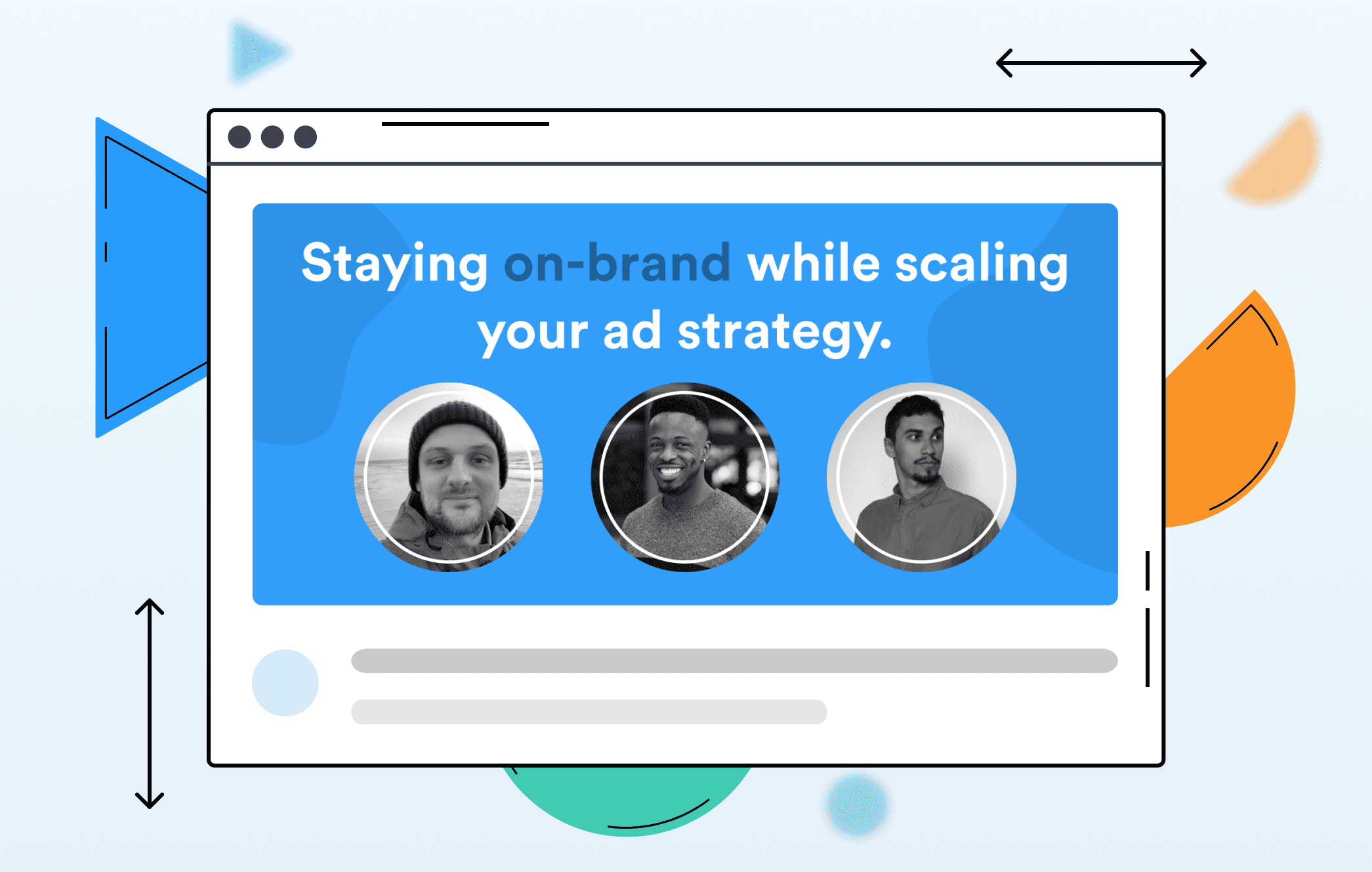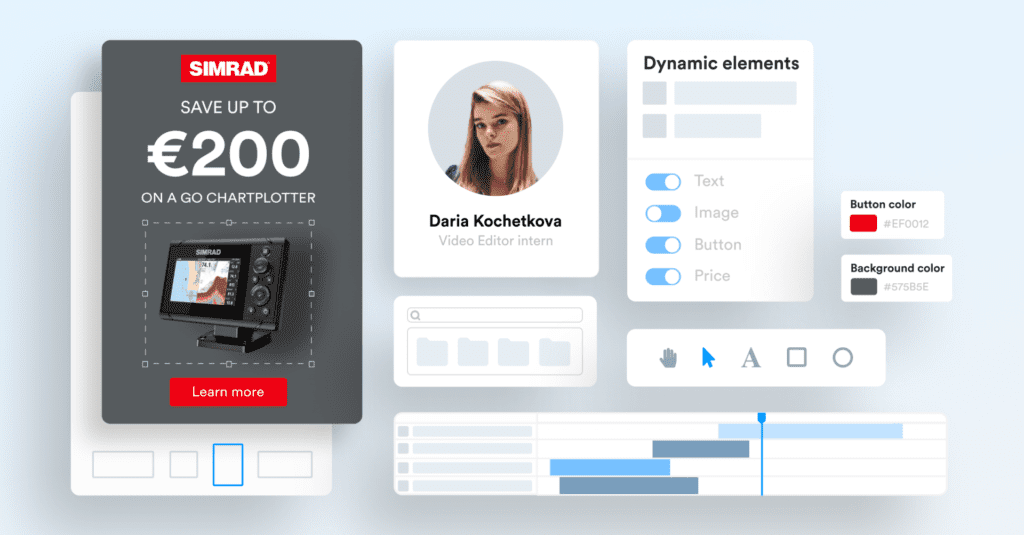A few weeks ago, a colleague and I pondered on the following question:
“Why are some digital marketing teams able to make their ad strategy look so effortless and still manage to keep a strong brand identity?”
So we looked at some companies and realized that some teams get amazing results by showing great creativity and personalization.
At the same time, we realized other companies seem to be so dependent on keeping their status quo that they take no action to advance their ad strategy and communicate directly with their audience.
We looked more deeply into this question and arrived at the following conclusion:
Well, it’s certainly not magic. The teams that have figured this out actually use a centralized way of working, put creativity at the forefront, and bank on the right platforms to create, measure, and test their ads – all while crafting ad experiences that bring value to their audience.
But how do they do this? In this article, we zoom in on some key approaches you can take to scale your ads while keeping quality and personalization as your foundation, and consumers at the forefront.
For an expert take, we spoke to Hakim Garuba, Performance Marketing Manager at Square, Maciej Turek, Head of Performance Marketing at bunq, and Juan Gutter, Performance Marketing Lead at Glovo, who have both strategic and tactical experience in establishing marketing automation and effective personalization in their organizations.
Let’s dive right in!
The importance of scaling your ads
Have you ever thought of the idea that if you scale your ads, everything else will fall into place? It may sound like a simple concept, yet bringing it to life can feel like a personal Everest if you lead a production team.
The reality is that the ad space is in constant flux and that means as both marketers and creative teams, you have to sift through growing roadblocks and figure out a system that propels you in the right direction.
At Storyteq, we’re constantly in the thick of working through how to help teams become more outcome-focused. So we did some research.
We learned that from a production perspective, there is an increasing demand for more efficient processes to create better ads and this stems from high editing costs, a slow time-to-market when it comes to launching ad campaigns or lacking control over the creative output that’s generated by both remote and centralized creative teams or agencies.
These problems become even more challenging when either your marketing or media department demands more content due to their ad strategies or when ad channels require you to create ads in a specific size or format, and you need to adapt it to a specific market.
At the core, we found three drivers that push marketers to rethink their strategy and create ads that keep their brand on point and their audience at the forefront. At the same time, marketers’ needs will implicitly affect the content production team as well:
🖥️ What does scaling your ads actually mean?
Scaling your ads is the process of using technology to help you automatically create multiple ads, by making components such as images, videos, titles, voice-over, descriptions, and CTAs interchangeable/dynamic in order to automate the production process.
1. Ad channels and formats become more versatile
As channels have evolved and multiplied, they also started introducing more formats. This has a cascading effect on marketers, who now need to consider what the right way to communicate with their audience is. Is it through banners? Or videos? And should these be generic or should they be personalized?
If we look at channels like YouTube, TikTok, Instagram, etc, we see they now handle (mostly) videos.
92% of marketers who use videos say that they have become an important part of their personalization strategy because not only do they resonate with people more, but they can introduce them across many stages of the marketing funnel and on different channels.
Video has become a popular format for good reasons – it’s engaging and humanizes a brand and it can be included in the marketing funnel in a sequential way, creating a storytelling effect.
But it also means, marketers need to create more videos that resonate with their audience. The beauty of automation is that it can handle creating video ads at scale, so a team’s capacity is no longer a barrier to growth.
2. Consumers want more personalized experiences
As people start demanding more relevant content, this equals the need to create more personalized ads.
When you’re creating ad experiences for thousands of people, you’re inevitably going to run into this problem: How do you make your outreach efficient but still human? Leveraging personalization enables you to lay the foundation for meaningful relationships and do so at scale.
Besides, you may have already realized that people are affected by banner blindness, meaning they have the tendency to ignore ads especially when they don’t speak directly to them.
This means that you now need to adapt your content to your audience’s needs. So within this process, the challenge goes back to creative teams who have to come up with strong assets that tell compelling stories.
3. Ad strategies are complex
Try to remember the ad space around a decade ago – it was most likely limited to running mass targeting ads on TV and creating some online campaigns followed by retargeting.
Today, along with new channels and formats, the digital space has opened up a whole new world of possibilities that go beyond the ad’s narrative: from hyper-targeted ads to dynamic creatives, used to target audiences based on who they are and where they’re located, these are just some of the forms ad campaigns can now take.
Now more than ever, marketers need to adapt their ad strategy to match people’s expectations.
If you ask how this can be solved, we’d say: start creating a system that helps you scale your ads effectively – this can already serve as the first line of defence for your team. We’ll show you how below.
A framework to scale your ads
Without a proper framework to create and scale ads, your department is left to rely on assumptions about what kind of experiences they can create for their audience.
Your assumptions might be good but they often resurface from previous experiences, which can prompt you to create ads based on what you think is right, giving your whole campaign a biased outlook.
In design, it’s known for creatives to consciously uncover biases by considering inclusive and thoughtful work. One way to do this is by tapping into Another Lens, a set of questions and guidelines that aim to help you balance your bias, consider the opposite, and embrace a growth mindset.
In digital advertising, you can also use this thinking to create ad experiences by consistently keeping your audience’s needs in mind and experimenting often to get the best outcomes.
In the case of Hakim Garuba, Performance Marketing Manager at Square, his team wanted to create experiences that help people so he framed different best-practices depending on the channels they wanted to leverage.
He says that it’s important to first know the tools or marketing channels at your disposal, and why you would use one versus or together with another.
“There isn’t a one-size-fits-all approach to scaling ad production. It’s important to test what works for you and be agile enough to quickly integrate learnings or pivot away from failures.”
Hakim Garuba, Performance Marketing Manager at Square
But while the exact framework you’ll use depends on your budget, resources, goals, time availability, and requirements, we recommend you to use the following steps as a template to guide your ad strategy.

That said, let’s walk you through the framework:
- Define the platforms and tools you’re working with
- Collaborate with stakeholders in your organization
- Understand your products and which features or benefits appeal to your audience
- Outline a hypothesis and testing framework for your ads
- Use metrics to determine success
- Create compelling creatives driven by initial marketing research
- Build a culture of experimentation
1. Ad channels and formats become more versatile
Technology helps you create, manage, track, and analyze ads and how they interact with your audience. In turn, these insights give you a better understanding of users’ behaviours, helping you to make informed ad decisions with real data.
For Hakim, marketing technology has become imperative to the creative process itself.
“We use ad-translation services to expedite the localization of ad copy. Also, bid strategies help us maximize our return on ad spend and manage bids at scale for multiple campaigns and so on,” he shares.
“There is so much information to process and technology helps us store, manage, and analyze that information in order to gain actionable insights that help drive our marketing strategy.”
Hakim Garuba, Performance Marketing Manager at Square
Maciej Turek, Head of Performance Marketing at bunq, also champions the idea of working with platforms to create better processes because he deeply understands the importance of scaling advertising.
“Whenever possible, automate all processes that will help you scale up your advertising. The upside is that translating or resizing to meet the specific channel requirements can be easily automated these days.”
Maciej Turek, Head of Performance Marketing at bunq
At the heart of any strategy is the ability to effectively plan, execute, manage, and measure ads. It’s that choreography which allows marketing teams to stay on top of things.
As Juan Gutter, Performance Marketing Lead at Glovo, explains it, technology is the center of all this work. “The work of a digital team is made from a tech stack that enables the execution and analysis to understand the data,” he shares.
According to Juan, each company will choose tools based on their needs and capabilities and the functions and capabilities will be defined by your company’s strategy.
As such, automation is an essential key to scale your business. Juan elaborates:
“My first challenge at Glovo was scaling from 5 countries to 20 in one year. I started setting up the global strategy for riders’ acquisition from scratch. My first question was how do I make my life easier? The answer was and still is automation.”
Juan Gutter, Performance Marketing Lead at Glovo
As Glovo expanded to new territories so were their ads and on a weekly basis, they were creating and updating budgets and creatives on many performance channels in more than four continents.
“Our strategy to keep up with business was to automate as many manual tasks as possible. We managed to do so by API connections with the platforms where we could modify thousands of campaigns with one click. As a result, we reduced the time on frivolous tasks by 20% on a weekly basis and focused more on content development and strategy.”
Juan Gutter, Performance Marketing Lead at Glovo
With this in mind, it’s not surprising that the benefits of the platforms you are tapping into extend beyond the execution side of things into giving you real insights to guide your ad strategy.
2. Collaborate with stakeholders in your organization
The saying “It takes a village” comes to mind when starting a new project. If your ad campaigns become successful, chances are a number of people helped you get there because no real work is actually done in a vacuum.
So it’s key to break the information silos in your organization and work closely with other departments to ensure your objectives and goals are aligned.
For Hakim, this cross-functional approach helps align the marketing objectives and how these ladder up to your business objectives. For instance, he asks: “Do Product Marketing Managers have specific goals? Are they aligned with your VP?”
“Marketing is becoming more full-funnel, so tighter collaboration with different teams across your organization (e.g. Sales, Product, Engineering, C-Suite) will typically result in better goal-setting and results.”
Hakim Garuba, Performance Marketing Manager at Square
As you start to see what really matters to other teams, you can reflect on whether the work you’re currently doing actually hits these priorities and goals and drive your attention in the right direction.
3. Understand your products and which features or benefits appeal to your audience
Consumers expect personalized experiences, which means that marketing teams need to learn as much as they can about their audience so their ads won’t look the same to everyone.
Just picture a classic newspaper with no proper segmentation. It’d actually be a disorganized mix of culture, sports, and foreign affairs articles. In advertising, we know that if we properly understand who we target and why, it’ll be much more effective for people to engage with us.
“It’s important to be user-centric and to try to create ads that clearly explain why your product is beneficial to the user. Always test new ideas, experiment, and scale up the things that are working.”
Maciej Turek, Head of Performance Marketing at bunq
In the end, being familiar with your audience’s wants and needs, as presented through data, helps you create better ad experiences.
But keep in mind that customer interactions with brands don’t happen in a single ad session: they interact with brands over extended periods of time and through a variety of different channels.
On this note, Juan points out that creating relevant content can often be an exhaustive work where many professionals from different specialties collaborate.
“The first step is understanding your clients – while demographics are crucial, you want to go as thoroughly as possible to understand what products or services are driving value to them.”
Juan Gutter, Performance Marketing Lead at Glovo
Breaking down your products into characteristics will give you the main messages to communicate and attract people to the desired action. Juan explains further:
“Each channel will have different characteristics defined by user behavior so understanding this will help you create engaging ads for every placement available.”
Juan Gutter, Performance Marketing Lead at Glovo
Traditional advertising wasn’t originally designed to connect with every single consumer at a granular level.
It may have excelled at reaching hundreds of thousands of consumers anonymously at a single point in time, but not the way real people actually interact with a brand.
However, modern advertising uses tools that can properly analyze complex customer data at every touchpoint.
“It’s important to conduct market research – either first-party or obtain secondary research – to understand your industry, competition, and external factors that could impact your ad performance. At the same time, it’s also crucial to look at historical data.”
Hakim Garuba, Performance Marketing Manager at Square
4. Outline a hypothesis and testing framework for your ads
Deciding how your team should manage your ad strategy can be a lot like climbing a ladder. On the lowest step is a problem you need to solve. At the top, you’ll see the impact and results you get on the campaign you are running.
But climbing a ladder requires you to take every step carefully, without skipping straight to the middle, which in your case is executing on your ad strategy.
Instead of trying to jump straight into execution, it’s important to pause and consider some made-up scenarios like: “How would this ad benefit the audience?” and “What sort of content does my audience consume, and why?”
Consider doing this by forming a hypothesis. By creating your strategy as a hypothesis rather than a plan, you create a cycle of learning, testing and adjusting, fueled by data that can be obtained through continuous execution.
For example, when considering verticalization and different language formats, Hakim says that it all boils down to asking questions like:
- “What if we identified the highest converting audiences for each of our products and developed rich media images and ad copy that was relevant to that target audience?”
- “Would this improve our success metrics?”
By asking questions, you start with the end goal in mind and work backwards so you can pave the way to what you need to achieve.
Whatever you do, remember that consumers expect a great experience – in the B2C world, experience matters – but for today’s modern consumer, value is now on par with experience.
5. Use metrics to determine success
A Zendesk report on customer experience trends shows that companies that leverage the most data create better experiences for their audience.
On the other side of the spectrum, consumers expect to receive messaging tailored to their interests and intent and they are more likely to purchase from a brand when they receive personally relevant content.
So when it comes to measuring success, there are few key driving factors to consider:
- Setting goals that are aligned with your strategic decisions
- Staying aligned with your North Star
- Having the right tech infrastructure to crunch the data
As Hakim explains it, Google Analytics 360 helps his team understand the behavior of their visitors and build audiences that they can leverage across the Google Marketing Platform. He shares:
“Depending on campaign objectives, we measure success by tracking a few metrics including but not limited to conversions, cost per conversion, return on ad spend (ROAS), LTV, Payback (in Quarters or Years).”
Hakim Garuba, Performance Marketing Manager at Square
Because this is a deeply interconnected system, and all parts can affect other seemingly unrelated parts of the system, having and measuring KPIs that reflect the value of the business is something vital to optimizing your ad performance so do consider metrics like CAC, Retention, and LTV.
6. Create compelling creatives driven by marketing research
If you ponder about what the key to successful advertising is, you’ll often come across the mantra of Dr. Stephan Vogel, Ogilvy & Mather Germany’s Chief Creative Officer:
“Nothing is more efficient than creative advertising. Creative advertising is more memorable, longer-lasting, works with less media spending, and builds a fan community…faster.”
But as with any marketing campaign, the success of ads comes down to a combination of creativity and data.
Strengthening the creative quality of digital display campaigns requires some work and investment, but strong creatives and proper testing can yield dramatic results.
“Content is king. As automation is taking over many tasks from marketers, we need to focus on developing the best content possible to improve our performance. Take time to analyze it and get amazing designers.”
Juan Gutter, Performance Marketing Lead at Glovo
By conceptualizing your creatives, you will give them a longer shelf life, all while keeping your design team focused on the creative process.
7. Build a culture of experimentation
You may already know that no strategy exists in a vacuum. A key part of creating good strategies goes back to the testing ground.
So how can you create systems, workflows, and processes that move conversations from one team to the next in order to keep things effective for your audience?
This could look like creating a seamless feedback data loop to know how consumers act on your campaigns and what you can tweak and improve.
As Maciej from bunq highlights, his team is developing an experimental flow where you measure the efficiency of new ads against the existing ones and strictly follow scientific methods to determine which ads are the most efficient. “Whenever we find the winning formula, we scale it up,” he shares.
“We usually run experiments simultaneously on all of our main markets, so we often see differences between what is appealing to the users in The Netherlands vs. Germany, or France. Based on the findings from these experiments, we then adjust our ads at the specific country level.”
Maciej Turek, Head of Performance Marketing at bunq
It’s important to continue testing new strategies, CTAs, copy, and images to optimize your campaigns. These experiments can also include A/B testing of different buying incentives like discounts versus free offers.
You can also see if various products or services lead to more clicks, and perhaps exchange product photos to see which engages audiences the most. Finally, you can tweak and test all kinds of elements to see which ad performs better. As Hakim puts it:
“I believe creating ads that really connect with your audience comes from having a culture of experimentation and testing. We continuously test our creatives and bring learnings from each experiment forward.”
Hakim Garuba, Performance Marketing Manager at Square
Alignment with these steps ensures that your audience gets value from your ad experiences. But to work at scale, it has to be driven by collaboration, follow clear goals, and be powered by automation.
How do you scale your ad strategy? We’d love to learn more about your practices.



